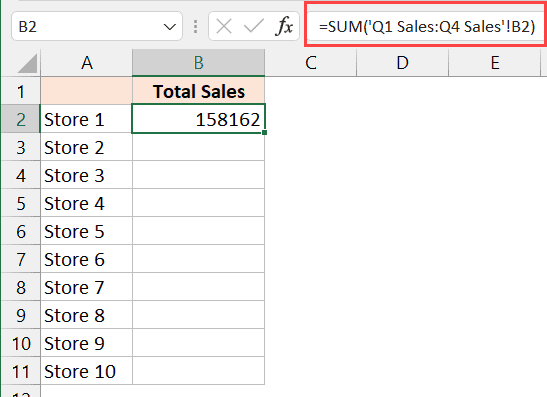3 Simple Ways to Sum Cells Across Excel Sheets

Dealing with large datasets in Microsoft Excel can often become a daunting task, especially when you're working with multiple sheets. Whether you're compiling quarterly financial reports, analyzing project data, or managing a team's performance metrics, the ability to sum cells across different sheets efficiently is crucial. This blog post will walk you through three simple methods to achieve this, making your data consolidation process both straightforward and time-efficient.
Method 1: Using 3D References

3D references allow you to sum data from the same cell or range of cells across multiple sheets. Here's how:
- Select the cell where you want the sum to appear.
- Enter your formula using the SUM function with a twist. Instead of single-sheet references, you'll use:
=SUM(Sheet1:Sheet3!A1)
Where:
- Sheet1 is the first sheet in your range,
- Sheet3 is the last, and
- A1 is the cell you wish to sum across these sheets.
This formula will add up the values in cell A1 from Sheet1 to Sheet3.
When to Use 3D References

- When you have a consistent structure across multiple sheets.
- Summing the same cell or range of cells.
📘 Note: The sheets must be sequential for 3D references to work.
Method 2: Consolidate Feature

Excel's Consolidate feature provides a more flexible approach to summing data across different sheets. Here's the process:
- Select your summary sheet where the results will go.
- Go to the Data tab and choose Consolidate.
- In the Consolidate dialog:
- Choose Function: Sum.
- Click Add to include ranges from other sheets (using 3D references).
- Select Top Row, Left Column, or Create links to source data if needed.
- Hit OK.
Excel will sum data from each referenced range and place the result in the summary sheet.
Advantages of Consolidation

- Can handle different sheet layouts.
- Allows for more complex calculations (not just summation).
- You can link back to the source data.
💡 Note: Consolidation creates dynamic references that update when the source data changes.
Method 3: Using Excel VBA

For those who love automation or need a more robust solution, VBA can sum cells across sheets programmatically:
- Press Alt + F11 to open the Visual Basic Editor.
- Insert a new module with Insert > Module.
- Write the following VBA code:
Sub SumAcrossSheets()
Dim ws As Worksheet
Dim total As Double
For Each ws In ThisWorkbook.Worksheets
If ws.Name <> "Summary" Then
total = total + ws.Range("A1").Value
End If
Next ws
Worksheets("Summary").Range("A1").Value = total
End Sub
This VBA script will sum the values in cell A1 from all sheets except the one named "Summary," placing the result in cell A1 of the Summary sheet.
Why Use VBA for Summing

- Allows for automation and customization.
- Can handle sheets with different names or layouts.
- Best for ongoing, repetitive tasks.
🧠 Note: Be cautious with VBA as it can significantly alter your workbook's functionality if not handled properly.
Enhancing Your Excel Workflow

By now, you've explored three distinct methods to sum cells across Excel sheets: 3D References, Consolidation, and VBA. Each approach offers its own set of benefits:
- 3D References for simple and sequential data aggregation,
- Consolidation for flexibility and dynamic updating,
- VBA for automation and complex task handling.
These techniques not only enhance your Excel skills but also help in creating a more efficient workflow, minimizing errors, and saving precious time on data manipulation tasks.
Remember, practice makes perfect. Start with the method that fits your immediate needs and expand your skills from there. Your ability to navigate and manipulate data across multiple sheets will undoubtedly become a cornerstone of your Excel prowess.
Can 3D References work if my sheets are not in order?

+
No, 3D references require the sheets to be in a sequential order for the reference to work correctly.
What if I need to sum data from non-adjacent sheets?

+
You would need to use either the Consolidate feature or write VBA to handle non-adjacent sheets.
How can I automate this process with changing sheet names?

+
VBA is your best option here as it can dynamically handle different sheet names or add new sheets as they come.



